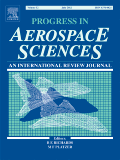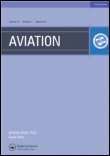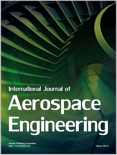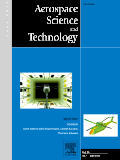
AEROSPACE AMERICA
Scope & Guideline
Advancing the Frontiers of Aerospace Knowledge
Introduction
Aims and Scopes
- Commercial Spaceflight Regulation:
The journal discusses the implications of regulating commercial human spaceflight, addressing safety, liability, and ethical considerations associated with this emerging industry. - Technological Innovations in Aerospace:
Aerospace America highlights breakthroughs in aviation technologies, including advancements in electric and hybrid aircraft, AI integration in cockpit systems, and enhancements in drone capabilities. - Sustainability and Environmental Impact:
The journal emphasizes the importance of sustainability within aerospace, covering topics such as decarbonization, the use of sustainable aviation fuels, and the environmental impacts of space launches. - Human Space Exploration and Robotics:
The publication explores the future of human space exploration, including missions to Mars, lunar bases, and the role of robotics in space missions, reflecting on both technical and human factors. - Safety and Risk Management:
Safety in aerospace operations is a critical focus, with discussions on collision avoidance, cybersecurity measures, and risk assessment methodologies to enhance operational safety.
Trending and Emerging
- Artificial Intelligence in Aerospace:
The integration of AI technologies in aerospace applications is gaining significant attention, focusing on enhancements in flight operations, predictive maintenance, and autonomous systems. - Advanced Air Mobility Solutions:
The journal increasingly covers topics related to advanced air mobility, including urban air taxis and eVTOL (electric Vertical Take-Off and Landing) aircraft, reflecting a growing interest in innovative transportation solutions. - Sustainability Initiatives:
There is a strong emphasis on sustainability initiatives, with articles discussing the development and implementation of sustainable aviation fuels and technologies aimed at reducing the carbon footprint of the aerospace sector. - Commercial Space Ventures:
The rise of commercial space ventures and private sector investments in space exploration is a trending theme, showcasing how private entities are shaping the future of space travel and exploration. - Cybersecurity in Aerospace Operations:
The importance of cybersecurity in aviation and space operations is increasingly recognized, with discussions on safeguarding systems against cyber threats and ensuring operational integrity.
Declining or Waning
- Traditional Propulsion Systems:
While traditional propulsion systems remain vital, there has been a noticeable shift towards innovative propulsion technologies such as electric and hybrid systems, leading to reduced emphasis on conventional engines. - Conventional Aircraft Design:
The journal has seen less coverage of conventional aircraft designs, as the industry increasingly shifts towards advanced air mobility solutions and innovative structural designs that prioritize efficiency and sustainability. - Space Debris Management:
Although still relevant, the frequency of articles specifically focused on space debris management and mitigation strategies has decreased, possibly due to a more general focus on broader space sustainability issues. - Military Aviation Innovations:
Discussions specifically centered on military aviation innovations have waned, as the journal's focus has shifted more towards civilian aerospace applications and technologies. - Legacy Systems and Technologies:
There is a reduced emphasis on legacy systems and technologies in aerospace, as the industry moves towards adopting cutting-edge technologies and modernizing existing platforms.
Similar Journals

Aerospace
Pioneering Research for Tomorrow's Aerospace LeadersAerospace is a premier open-access journal published by MDPI, established in 2014 and dedicated to the dynamic field of aerospace engineering. With an impressive Q2 ranking in the 2023 category of Aerospace Engineering, this journal is a vital resource for researchers, professionals, and students interested in advancements and innovations in aerodynamics, avionics, propulsion, and more. Operating from Switzerland, Aerospace provides a platform for the dissemination of high-quality research articles and reviews, contributing to the ongoing dialogue in the aerospace community. This journal not only enhances visibility through its open access model but also ensures that critical knowledge is freely available, fostering collaborative efforts and inspiring the next generation of aerospace engineers. With a Scopus ranking of #60 out of 153 in the Aerospace Engineering category, it plays a significant role in shaping the future of aviation and space exploration.

JOURNAL OF THE ASTRONAUTICAL SCIENCES
Innovating the Future of Planetary ScienceJOURNAL OF THE ASTRONAUTICAL SCIENCES, published by Springer Heidelberg, serves as a leading platform dedicated to advancing the fields of aerospace engineering and planetary science. With an ISSN of 0021-9142 and an E-ISSN of 2195-0571, this journal has established a significant presence within the academic community, evidenced by its categorization in the Q2 and Q3 quartiles for 2023, positioning it among the top publications in its field. The journal encompasses a spectrum of research that spans from innovative aerospace technologies to the exploration of planetary systems, reflecting its rich scope developed since its inception in 1969. Although not Open Access, it provides vital contributions to ongoing discussions in aerospace research, appealing to researchers, professionals, and students eager to deepen their understanding of astronautics. With a notable impact factor and rankings in Scopus—66th in Aerospace Engineering and 64th in Space and Planetary Science—this journal continues to be a pivotal resource for those engaged in the exploration and utilization of space.

Advances in Aircraft and Spacecraft Science
Advancing Technologies that Propel Aviation and SpacecraftAdvances in Aircraft and Spacecraft Science is a distinguished journal published by TECHNO-PRESS, focusing on the rapidly evolving fields of aerospace engineering and fluid dynamics. With an ISSN of 2287-528X and an E-ISSN of 2287-5271, this journal is an invaluable resource for researchers, professionals, and students dedicated to advancing knowledge in aircraft and spacecraft technologies. Established in 2014, the journal is committed to disseminating high-quality research findings and innovative methodologies, ensuring that cutting-edge studies can be accessed globally. Despite its current position in the Q4 category for both aerospace engineering and fluid flow transfer processes, it continues to carve a niche in the academic landscape, with Scopus rankings highlighting its contribution to these fields. Operating from South Korea, Advances in Aircraft and Spacecraft Science aims to inspire collaboration and knowledge-sharing among scholars, fostering advancements that drive the aerospace industry forward.

PROGRESS IN AEROSPACE SCIENCES
Transforming aerospace knowledge into practical advancements.PROGRESS IN AEROSPACE SCIENCES is a prestigious journal published by PERGAMON-ELSEVIER SCIENCE LTD, recognized as a leading platform in the field of aerospace engineering, mechanical engineering, and mechanics of materials. With an impressive history dating back to 1961, the journal covers a wide spectrum of topics pivotal to advancing aerospace technology and innovation. Its recent ranking as Q1 in multiple engineering categories underscores its significance, ranking #1 in Aerospace Engineering and placing within the top 20 percentile in both Mechanical Engineering and Mechanics of Materials, according to Scopus assessments. Researchers, professionals, and students looking to engage with high-impact research will find PROGRESS IN AEROSPACE SCIENCES an invaluable resource, offering insights into cutting-edge developments and methodologies. Although it does not operate under an open-access model, the journal upholds rigorous peer-review standards, ensuring that the published content meets the highest academic integrity. Situated in the United Kingdom, it plays a critical role in fostering international collaboration and knowledge-sharing in the aerospace sector.

Aviation
Unlocking the future of flight through open-access research.Aviation, published by Vilnius Gediminas Technical University, is a leading open-access journal dedicated to the dynamic field of aerospace engineering, with an ISSN of 1648-7788 and E-ISSN of 1822-4180. Established in 2004 and set to converge in 2024, this journal aims to disseminate high-quality research that advances the understanding and application of aerospace technology. With an impact factor reflective of its contribution to the discipline, Aviation ranks at Q4 in the Aerospace Engineering category and occupies the 80th position out of 153 in Scopus, highlighting its growing significance among scholarly publications. By providing free access to its content since 2018, the journal enhances its reach and encourages collaborative efforts in the academic community, catering to researchers, professionals, and students eager to explore innovative studies and findings within aerospace engineering. Based in Lithuania, this journal serves as a vital resource for those aiming to contribute to the future of aviation.

International Journal of Aerospace Engineering
Advancing Knowledge, Shaping the SkiesThe International Journal of Aerospace Engineering, published by HINDAWI LTD, stands at the forefront of innovation and research in the field of aerospace engineering. With an impact factor reflecting its contributions to the discipline and classified in Quartile 3 (Q3) for the year 2023, this journal provides a platform for high-quality, peer-reviewed articles that delve into advancements and challenges in aerospace technology and applications. Since its inception in 2008, the journal has embraced an Open Access model, promoting unrestricted dissemination of research findings to foster collaboration and knowledge sharing among researchers, professionals, and academia. The journal covers a broad spectrum of topics, aiming to enhance understanding and give insight into aerospace engineering's multifaceted aspects. With its coverage in the Scopus database, ranking 71 out of 153 in the aerospace engineering category, the journal is a valuable resource for those engaged in this dynamic field, ensuring that high-impact research receives the visibility it deserves.

AIRCRAFT ENGINEERING AND AEROSPACE TECHNOLOGY
Advancing aerospace innovation through rigorous research.AIRCRAFT ENGINEERING AND AEROSPACE TECHNOLOGY, published by Emerald Group Publishing Ltd, is a leading peer-reviewed journal dedicated to advancing the fields of aerospace engineering and technology. With a strong emphasis on innovative research, the journal aims to bridge theoretical developments and practical applications within the aerospace sector. Although the journal does not currently offer open access, it continues to enrich the academic community's understanding of aircraft design, maintenance, and engineering processes, making it a crucial resource for researchers, professionals, and students alike. By fostering a rigorous dialogue among experts, AIRCRAFT ENGINEERING AND AEROSPACE TECHNOLOGY ensures the dissemination of cutting-edge findings and promotes sustainable practices in the aerospace industry, highlighted by its commitment to high-quality scholarship.

Aerospace Science and Technology
Transforming Ideas into Aerospace InnovationsAerospace Science and Technology, published by ELSEVIER FRANCE-EDITIONS SCIENTIFIQUES MEDICALES ELSEVIER, is a leading journal in the field of aerospace engineering, boasting an impressive 2023 Q1 ranking and a significant position in the Scopus Ranks, where it stands at Rank #7 out of 153 in the Engineering - Aerospace Engineering category, reflecting its credibility and impact with a 95th percentile ranking. Since its inception in 1997, this journal has provided a robust platform for the dissemination of pioneering research and advancements in aerospace technology, focusing on innovative methodologies and applications in the aerospace sector. With a commitment to open access, researchers, professionals, and students can easily engage with cutting-edge findings that drive the industry forward. The journal not only seeks to expand knowledge but also aims to foster collaboration among scholars across the globe, making it an essential resource for anyone looking to stay at the forefront of aerospace innovation. For more information, visit its website or refer to its dedicated address at 65 Rue Camille Desmoulins, CS50083, 92442 Issy-Les-Moulineaux, France.

New Space-The Journal of Space Entrepreneurship and Innovation
Navigating the Nexus of Business and AerospaceNew Space - The Journal of Space Entrepreneurship and Innovation is a pivotal publication dedicated to advancing the field of aerospace through innovative research and practical insights. Published by Mary Ann Liebert, Inc., this journal serves as a crucial platform for scholars, engineers, and entrepreneurs interested in the burgeoning sectors of space technology and commercial space endeavors. With an ISSN of 2168-0256 and an E-ISSN of 2168-0264, New Space explores the intersection of engineering, sustainability, and business within the aerospace industry. The journal's impact is highlighted by its Q3 ranking in multiple categories, including Aerospace Engineering and Astronomy and Astrophysics, signifying its relevance in contemporary research dialogues. Although currently closed access, the journal's dedication to fostering innovations is clear as it addresses critical topics from safety and risk management to energy technologies and tourism in space contexts. Researchers and professionals seeking to influence the future of space entrepreneurship will find valuable content and a collaborative community within these pages, making New Space an essential resource in its field.

International Journal of Aviation Aeronautics and Aerospace
Fostering Collaboration for a Safer Aviation FutureInternational Journal of Aviation Aeronautics and Aerospace, published by Embry-Riddle Aeronautical University, serves as a pivotal platform for the dissemination of innovative research in the fields of aerospace engineering, civil and structural engineering, and safety, risk, reliability, and quality. With an ISSN of 2374-6793 and designated as an open access journal since 2014, it enables unhindered global access to its scholarly content, fostering collaboration among researchers, professionals, and students in the aviation sector. The journal's presence spans from 2014 to 2024 and is recognized within the Q3 category across multiple engineering domains according to recent metrics. Despite its emerging status, it holds respectable rankings in Scopus, demonstrating its relevance and contribution to the academic community, particularly in dynamic engineering sectors. It is an essential resource for anyone looking to enhance their understanding of advancements and challenges in aviation and aerospace solutions.